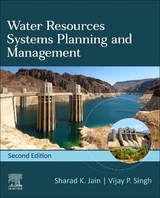
Water Resources Systems Planning and Management
Elsevier Science Ltd (Verlag)
9780444514295 (ISBN)
- Titel erscheint in neuer Auflage
- Artikel merken
This book is divided into four parts. The first part, Preliminaries, begins by introducing the basic theme of the book. It provides an overview of the current status of water resources utilization, the likely scenario of future demands, and advantages and disadvantages of systems techniques. An understanding of how the hydrological data are measured and processed is important before undertaking any analysis. The discussion is extended to emerging techniques, such as Remote Sensing, GIS, Artificial Neural Networks, and Expert Systems. The statistical tools for data analysis including commonly used probability distributions, parameter estimation, regression and correlation, frequency analysis, and time-series analysis are discussed in a separate chapter. Part 2 Decision Making, is a bouquet of techniques organized in 4 chapters. After discussing optimization and simulation, the techniques of economic analysis are covered. Recently, environmental and social aspects, and rehabilitation and resettlement of project-affected people have come to occupy a central stage in water resources management and any good book is incomplete unless these topics are adequately covered. The concept of rational decision making along with risk, reliability, and uncertainty aspects form subject matter of a chapter. With these analytical tools, the practitioner is well equipped to take a rational decision for water resources utilization. Part 3 deals with Water Resources Planning and Development. This part discusses the concepts of planning, the planning process, integrated planning, public involvement, and reservoir sizing.The last part focuses on Systems Operation and Management. After a resource is developed, it is essential to manage it in the best possible way. Many dams around the world are losing some storage capacity every year due to sedimentation and therefore, the assessment and management of reservoir sedimentation is described in details. No analysis of water resources systems is complete without consideration of water quality. A river basin is the natural unit in which water occurs. The final chapter discusses various issues related to holistic management of a river basin.
Dr. Sharad Jain is Visiting Professor, Civil Engineering Department, IIT Roorkee, India. He was the Director, National Institute of Hydrology, Roorkee, India, during 2017-20. He was a Post-Doctoral fellow in Japan and Visiting Professor at the Louisiana State University, USA, for one year. During Apr. 2009 – Apr. 2012, he was NEEPCO Chair Professor at IIT Roorkee. He is also Adjunct Professor, Department of Civil Engineering, IIT Madras, Chennai. His research interests include Surface Water Hydrology, Water Resources Planning and Management, Impact of Climate Change, Application of Advanced Tools such as Artificial Neural Networks and Remote Sensing & GIS, and water governance. Dr. Jain has co-authored five books and has edited five books, wrote 25 book-chapters, nine articles in Encyclopedias, and more than 290 papers. He has organized > 30 short-term courses and worked on > 30 research and consultancy projects. Dr Jain has developed a web-based course under NPTEL (E-learning program of IITs). His group has developed a software package to perform a range of analyses related with sizing, flood routing, yield estimation, and operation of a system of reservoirs that may be encompassing multiple basins. The group led by Dr Jain has carried out many modeling studies and has set up an instrumented experimental catchment on Henval river in the Upper Ganga Basin. Dr. Jain is a member of editorial board of many journals and Chairman/ member of many technical committees. V.P. Singh is a Professor of Water Engineering at Texas A and M University. Over his career he has won numerous awards including the Engineering Medal of Achievement (University of Guelph, Guelph, Canada, 2017) and the Ven Te Chow lecture and Award (International Water Resources Association, 2017). He has published numerous books and journal articles and his research focuses on surface-water Hydrology, Groundwater Hydrology, Hydraulics, Irrigation Engineering, Environmental Quality and Water Resources. Principal research topics have encompassed: 1. Watershed modeling, 2. Erosion and Sediment Transport in Upland Watersheds, 3. Streamflow Forecasting, 4. Dam Break Analysis, 5. Entropy-Based Modeling, 6. Network Design, 7. Groundwater Modeling, and 8. Hydrologic Impacts of Climate Change.
Preface. Acknowledgments. Part I. Preliminaries. 1. Introduction to water resources systems. 2. Acquisition and processing of water resources data. 3. Emerging techniques for data acquisition and systems modeling. 4. Statistical techniques for data analysis. Part II. Decision Making. 5. Systems analysis techniques. 6. Economic considerations. 7. Environmental and social considerations. 8. Rational decision making. Part III. Water Resources Planning and Development. 9. Water resources planning. 10. Reservoir sizing. Part IV. Systems Operation and Management. 11. Reservoir operation. 12. Reservoir sedimentation. 13. Water quality modeling. 14. River basin planning and management. Appendix A. Appendix B. Index.
| Erscheint lt. Verlag | 12.9.2003 |
|---|---|
| Reihe/Serie | Developments in Water Science |
| Verlagsort | Oxford |
| Sprache | englisch |
| Maße | 175 x 244 mm |
| Gewicht | 1600 g |
| Themenwelt | Naturwissenschaften ► Biologie ► Ökologie / Naturschutz |
| Technik ► Umwelttechnik / Biotechnologie | |
| ISBN-13 | 9780444514295 / 9780444514295 |
| Zustand | Neuware |
| Informationen gemäß Produktsicherheitsverordnung (GPSR) | |
| Haben Sie eine Frage zum Produkt? |
aus dem Bereich



